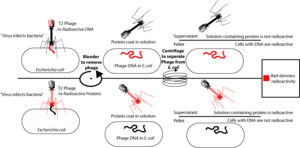This article relies largely or entirely on a single source. |
The Hershey–Chase experiments were a series of experiments started in 1952 by Alfred Hershey and Martha Chase.

These experiments were to confirm that DNA was the genetic material in living things, which had previously been discovered by the Swiss physician Friedrich Miescher in his experiments on white blood cells, or leukocytes, between 1868 and 69. Hershey shared the 1969 Nobel Prize in Physiology or Medicine for his “discoveries concerning the genetic structure of viruses.”
Method
changeHershey and Chase used T2 phage, a bacteriophage. The phage infects a bacterium by attaching to it and injecting its genetic material into it.
They labeled the phage DNA with radioactive Phosphorus-32. They then followed the phages while they infected E. coli. They found that the radioactive element left on the phage's DNA was only in the bacterium, and not in the phage, meaning that the DNA had entered the bacterium.
In a second experiment, Hershey and Chase put labels on the phage protein with radioactive Sulfur-35. After the phage was attached to the bacterium, the radioactive element was found in the phage, but not in the bacterium. This means that the phage's proteins stayed on the outside of the bacterium. These results showed Hershey and Chase that the genetic material that infects the bacteria is DNA.
References
change- Hershey A.D. and Chase M. (1952) Independent functions of viral protein and nucleic acid in growth of bacteriophage. J Gen Physiol. 36:39-56.